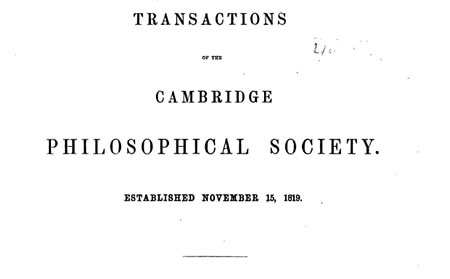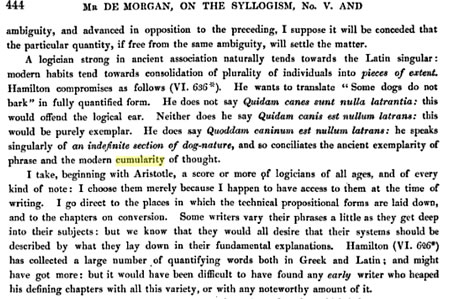
Cloud mind: the metaphor of fluent vapor — the clouded allegory in the context of computing, burgeoning creative, a multiplicity of minds: amassed.
“A person using cumular language would say that a universal negative is upset not only by predication of all, but of some; he would never say that “none are” is contradicted by “all are” and also by “some one is”; he would certainly find intermediate room for the indefinite plural some.” DE MORGAN, “ON THE SYLLOGISM” Transactions of the Cambridge Philosophical Society, 1850, pg. 444.
In an Aristotelian retort, what this means is that the one, even the “no one“, is some one — the effect, in advancement, is cumulative. Nothing: to one, to many.
I like metaphors.
I savor thinking metaphorically, skirting the surface, heading for what’s beneath. Cloud computing presumes that massing clouded computing networks, like a rising storm, builds vast computational / processing > consumer relationship enhancement capacities. Do lots more, because you have more networked “vapor”, flowing together, to achieve a ever moving goal.
In the Northwest, cloud computing is a big thing. We’ve got lots of need for it. Bezos is all over the premise — the promise — of cloud(ed) computing; David Sabey‘s been preaching the real estate economics of change in Washington (and building computing cloud centers) There’s a spin out there on another power collation, Apple | Google. And Google (and others) talk about the cloud in a bigger, even more abstracted way.
I’m fascinated by metaphorical thinking — and, in one manner or another — have been examining that idea of metaphor in brand development for a couple of decades. It reaches to the more poetic side of the question – what does something feel like? And that’s a question that I find myself increasingly asking. Or rather, one that we are asking increasingly — what, in the work that we do, is evinced in the emotionality of relationship — and the relating — of content. How do you get it? How do you get there? What is the shape of emotion in content / context? Metaphors, as catalysts, can bridge that equation.
Brand, audience, relatedness.
To that end, I’ve been thinking about Amazon and some of the metaphors that are there, inherent in that corporate construct — the work, the meaning, the symbolism. To that end, exploring relationships, I’ve been working on the concept of Amazon as a metaphor in relationships and community. How organically, the spirit of Amazon is really about the nearly osmotic inter-relatedness between the person, the brand, the brand, the person. And what could that look like, and feel like, if it was not merely about the online sense of place, but more so, about the built experience.
That is, if you were to build something that would tell the Amazon story, what would it be? Dawn Clark and I are working on that — building a conceptual metaphor for the telling of Amazon “stories”, in experience. More on that soon.
But, speaking allegorically about clouds, what are the layers of content, to their symbolism. Clouds, etymologically, come from clumps; and they’re defined in height and layers. They’ve been called, as well, stones. O.E. clud “mass of rock,” from P.Gmc. *kludas, metaphoric extension 13c. based on similarity of cumulus clouds and rock masses. O.E. word for “cloud” was weolcan. Cloudy is O.E. cludig (in the rock sense), in the water vapor sense, c.1300. Cloudburst (1817, Amer.Eng.) parallels Ger. Wolkenbruch. The imaginary city Cloud Cuckoo Land, built in air, is from Aristophanes’ Nephelokokkygia in “The Birds” (414 B.C.E.). Cloud nine is 1950s, Amer.Eng., of uncertain origin or significance. There was a similar association of cloud seven, but some connect the phrase with the 1896 International Cloud-Atlas, long the basic source for cloud shapes, in which, of the ten cloud types, cloud No. 9, cumulonimbus, was the biggest, puffiest, most comfortable-looking.
Cumulonimbus, the 9th cloud, is one of my favorites — stormbringer. In studying clouds, I reached back to the history (of the words, but as well, of their classification); and as well, the notion of cumular formation — the piling of icy, vapored content — or, for that matter, merely “amassment” up “information”: cu⋅mu⋅late, adjective–verb (used with object)
1. to heap up; amass; accumulate.
–adjective
2. heaped up.
Origin:
1525–35; < L cumulātus (ptp. of cumulāre to heap up, pile up, accumulate), equiv. to cumul(us) a heap, pile, mass, cumulus + -ātus -ate.
There’s more, of course, to the concept of cloud, computing and calculation and the cumulant. I couldn’t hope to comment on this added mathematical expansion.
What I’m curious about is the idea of the cloud, the cumular as a metaphor for acquisitive knowledge, team knowledge, the nature of the aggregated human content, the spirit of gathered instinct — the human cloud. Cloud mind, the palace of memory, crowd control.

In the beginning, the concept of the brandstorm, the metaphorical “storming” of people on brands and ideals was created in the form of the BrandQuest® as a tool to use that collated mind (fullness). Early on, in my career, I realized that there was no way for me, personally, to fully utilize the capacity of my mind, single mind, on the conception of a problem>solution scenario. I had to, instead, gather many minds. From the clients that work on the challenge, to the concept of Girvin teams linking into the concept of exploring the challenge and nature of the problem, and where, and how, it might be solved. We’ve got ideas and tools, to cloud talent, and build solution paths, metaphors for how people connect, experience, and stride into brand meaning and community in relationship(s).
Speaking of this, in seeking out expansions on the cloud(ed) metaphor — nimbus, cirrus, stratos the added https://www.girvin.com//?s=cumularitysymbolism of cloud mind, there’s this.
That’s it. Cumulate. And…

(this, coincidentally, is copyrighted, but I don’t know by who, the site link goes no where; the link is unbridged — the link, above)
TSG
Exploring brand+mind+cloud:
brandquesting
Tim Girvin | GIRVIN
New York City + Seattle | Tokyo
work: https://www.girvin.com
truth: http://www.tim.girvin.com/
reels: http://www.youtube.com/user/GIRVIN888
blogs:
https://tim.girvin.com/index.php
http://blog.girvin.com
Twitter: http://twitter.com/tgirvin